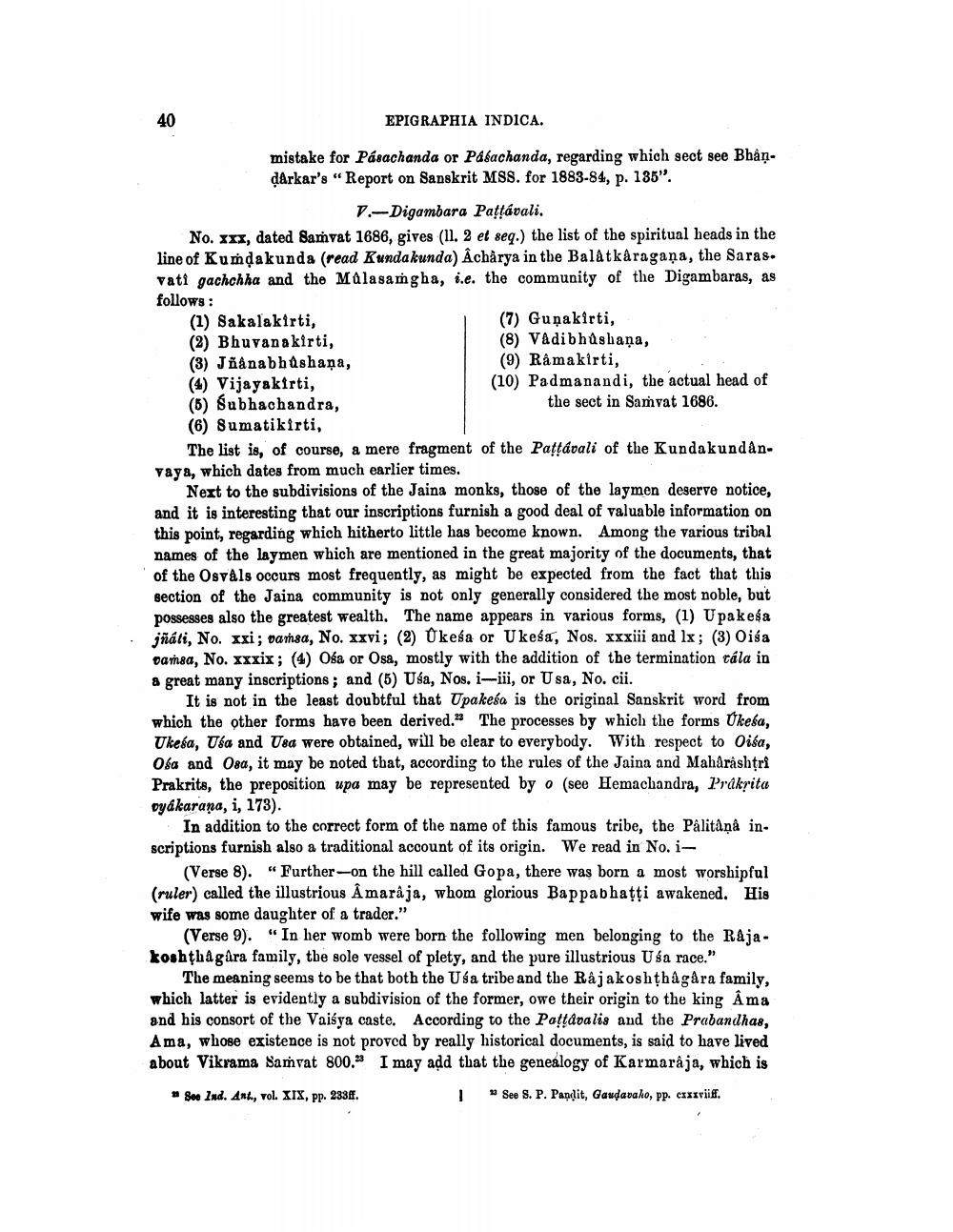________________
EPIGRAPHIA INDICA.
mistake for Pasachanda or Palachanda, regarding which sest see Bhân. darkar's "Report on Sanskrit MSS. for 1883-84, p. 185".
1.-Digambara Pattávali. No. Xxx, dated Samvat 1686, gives (11.2 et seq.) the list of the spiritual heads in the line of Kumdakunda (read Kunda kunda) Acharya in the Balatkâragana, the Saras. vati gachchha and the Malasamgha, i.e. the community of the Digambaras, as follows: (1) Sakalakirti,
(7) Gunakirti, (2) Bhuvana kirti,
(8) Vadibhushana, (3) Jñanabhashana,
(9) Ramakirti, (4) Vijayakirti,
(10) Padmanandi, the actual head of (6) Subhachandra,
the sect in Samvat 1686. (6) Sumatikirti,
The list is, of course, a mere fragment of the Pattávali of the Kundakundanvaya, which dates from much earlier times.
Next to the subdivisions of the Jaina monks, those of the laymen deserve notice, and it is interesting that our inscriptions furnish a good deal of valuable information on this point, regarding which hitherto little has become known. Among the various tribal names of the laymen which are mentioned in the great majority of the documents, that of the Osvals occurs most frequently, as might be expected from the fact that this section of the Jaina community is not only generally considered the most noble, but possesses also the greatest wealth. The name appears in various forms, (1) U pakeša jñáli, No. xxi; paṁsa, No. xxvi; (2) Okeśa or Ukeśa, Nos. xxxiii and lx; (3) Oisa Damsa, No. xxxix; (4) Ośa or Osa, mostly with the addition of the termination rála in a great many inscriptions; and (5) Usa, Nos. i-iii, or Usa, No. cii.
It is not in the least doubtful that Upakeśa is the original Sanskrit word from which the other forms have been derived." The processes by which the forms Ukesa,
Ukeba, Usa and Usa were obtained, will be clear to everybody. With respect to Oiša, Ośa and Osa, it may be noted that, according to the rules of the Jaina and Maharashtri Prakrits, the preposition upa may be represented by o (see Hemachandra, Prakrita oydkarana, i, 173).
In addition to the correct form of the name of this famous tribe, the Pålitàņa in. scriptions furnish also a traditional account of its origin. We read in No. i
(Verse 8). "Further-on the hill called Gopa, there was born a most worshipful (ruler) called the illustrious Amaraja, whom glorious Bappabhatti awakened. His wife was some daughter of a trader."
(Verse 9). "In her womb were born the following men belonging to the Rajakoshthågåra family, the sole vessel of plety, and the pure illustrious Usa race."
The meaning seems to be that both the Usa tribe and the Rajakoshțhågåra family, which latter is evidently a subdivision of the former, owe their origin to the king Ama and his consort of the Vaiśya caste. According to the Pattadalis and the Prabandhas, Ama, whose existence is not proved by really historical documents, is said to have lived about Vikrama Samvat 800." I may add that the genealogy of Karmaraja, which is * See Ind. Ant., vol. XIX, pp. 2334.
See S. P. Pandit, Gaudavako, pp. cxxxviiff.




